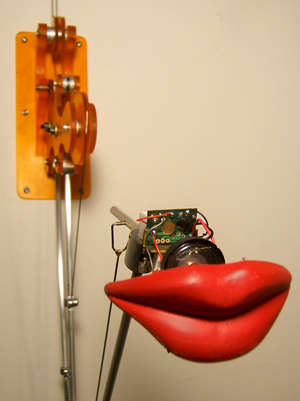Tucked into CNN’s Lilly Workneh’s “Top 10 Most Bizarre Tech Stories of 2011” are two amazing new devices from Japan that I somehow missed this past year. I won’t dispute that they’re bizarre from one perspective. But I get a full-on robot chubby seeing devices adapted for this level of technoaffection.
The first invention is the Kiss Transmission Device, from Tokyo’s Kajimoto Laboratory, which is part of the University of Electro-Communications. The device allows virtual French kisses (Japanese kisses?) over chat:
Simply wiggle your tongue on a plastic straw, and it will transmit a signal that remotely makes another plastic straw wiggle — presumably while it is in your lover’s mouth.
[Link.]
No, unfortunately the device at the top of this post is not the Kiss Transmission Device; it’s a 2008 interactive sculpture by Ben Crowden. But it appears way sexier than the Kajimoto kissing machine, which looks like a dental device — or like one of the assistance devices designed for quadriplegics. The only other serious contender in the narrow field of kissing machines is this famed 1939 device from Max Factor.
More on the kissing machine in a moment, but in the meantime, let’s talk about a more recent development — “Hug-chan,” Samsung’s Android-powered hugbot, which occupies the Samsung Galaxy Café in Tokyo. It comes to us from 9to5Google.com, where Christian Zibreg condenses a post from the Samsung site, where there’s even a live robo-hug-cam.
A Galaxy S smartphone issues commands to a Galaxy Tab 10.1 LTE tablet that provides computer vision through its front and back cameras. It also controls the robot’s arms, legs and other moving parts. It doubles as Hug-chan’s charming head with eyes and other facial expressions rendered on the tablet’s display. In addition to the tablet camera, Hug-chan has a few cameras to detect and interact with users. Samsung even set up a website that lets people watch a live video stream from Hug-chan’s cameras.
[Link.]
What is uterly fascinating, as Violet pointed out to me, is that they’ve attached the suffix “-chan” to the name; as many of you probably know, it’s a diminutive appendage of endearment added on to feminine names. Is Samsung saying that the fact that chicks dig hugs will transcends not just species but the leap between biological vs. technological life?
Below is a video of Hug-chan in action, and more behind-the-scenes fun can be found here.
Okay, now that the hugs are out of the way, let’s get back to French kissing, and specifically the kissing machine.
First reported in May of this year, the Kiss Transmission Device would have many more applications than just its conceived purpose of transmitting RT kisses between IRL partners. In fact, at least one suggestion seems (to me) to map perfectly to the Japanese culture of pop idols, in the most wonderful possible way:
The idea is to help lovers — in long-distance relationships, say — by transmitting the tactile sensation of kissing from one person to another. The lab is running both devices on the same computer, but says a system could be set up to connect them via the Web.
“Kiss information” can be recorded and replayed, presumably meaning someone could save and share a “kiss” over and over.
“For example, if you have a popular entertainer use this device and record it, that could be hugely popular if you offer it to fans,” [Researcher Nobuhiro] Takahashi says.
The researchers seem to realize that most people might not exactly find licking a plastic tube a suitable replacement for sucking face. But there are refinements on the way, they say.
“The elements of a kiss include the sense of taste, the manner of breathing and the moistness of the tongue,” Takahashi said. “If we can re-create all of those, I think it will be a really powerful device.”
[Link.]
The applicability of this technology to virtual oral sex is obvious, especially when you factor porn performers into the mix. Downloadable lick-job from Bobbi Starr, anyone?
But as it relates to kissing, “French kissing” really isn’t accurate; I see no lips in evidence. This looks like tongue-kissing to me…as in kissing a disembodied tongue, which for me becomes the first hotness-limiting factor.
I’m a child of the ’80s, so disembodied tongues of any sort immediately call to mind a particularly ghoulish scene in A Nightmare on Elm Street — they have ever since I saw my first creepy example of “The Tongue,” as we used to call the cheap, disembodied-tongue vibrators we refused to carry at Good Vibrations (because they didn’t work, and almost everyone found them creepy). These vibrators didn’t do what tongues do — move like tongues, supple, wet and beautiful. They pretty much sat there vibrating, just like any other vibrator.
That was in the early 2000s. Newer versions of tongue-like sex toys lik the Magic Tongue have improved the model somewhat for oral sex, but not for kissing — and not by much. They remain, basically, vibrators. The most innovative oral-sex-simulating devices are ones like The Sqweel, a multi-tongue wheel which abandons concepts of human anatomy almost (but not quite) altogether. There are also attachments for the Sqweel called Sqweelers, which abandon anatomy even further — and the device’s less expensive cousin The Sqweevee, which is designed to ride on one’s (anatomical or strapped-on) cock. Then there’s JimmyJane’s Form 3, a clit vibrator — reportedly effective, but at best only vaguely tongue-like.
In order to actually kiss, a tongue needs to do a hell of a lot more than just vibrate; in fact, if someone’s tongue vibrated while kissing me, I think I would run for the hills. A tongue that vibrates is of little kissing utility. For most people, it’s of little utility anywhere except a clit (and maybe some other highly erogenous zones).
A kissable tongue needs to wiggle, wobble, slip, slide, relax, and contract. Even leaving aside the desire for something attached to that tongue that might (hopefully) purr, pant, mewl, sigh, whimper, and look hot in lipstick, the Kiss Transmission Device is much closer to my dreamt-of RealKiss model than anything the commercial world has offered so far (including the sort of highly-customized devices you see at, say, Fucking Machines).
I think the inclusion of kisses in a virtual-sex model is totally fascinating and hot. It may seem creepy to those of you for whom the Uncanny Valley is a vast chasm, but for me, there’s a far more important question of human development at stake. Because of the transmissibility of voice, text, photo and video information, those elements become the chief ingredients of any virtual sex model. As a result, as technology enables many of us live a larger part of our sex lives through fantasy, distance learning, out-of-town lovers and other forms of non-in-person sexuality, our sexual responses, interests and skills migrate toward the elements that are easily transmissible or replicable with technology.
The result? An expanded model of human sexuality that is, by the very techniques and developments that enable its expansion, limited.
Sex toys of all forms — especially remotely-controlled ones — can broaden those horizons immensely, but for many people the elements that matter most about in-person sex are ones that don’t have an easy, efficient or effective analog in the sex toy world — kissing and oral sex, plus (or including) smell, taste, and forms of touch that just don’t have an analog within the “vibrate, twist, whirr” model of common commercial sex toys — or even the “thrust” and “shock” available to people with more money to spend and/or days or weeks to spend customizing their devices, plus the expertise to do so.
Those forms of touch — caresses, embraces, hugs — have to be included in any truly preference-inclusive model of technological sex — from distance sex to artificial intelligence to the for-now fantasy-only frontiers of (be still my heart) robosex. Any real distance-sex or machine-loving model simply has to include techno-affection, not just technosex, to achieve anything approaching sexual inclusivity.
Sure, a truly interactive and wiggly robotongue is going to make some of us squee — sometimes — but there remains the need for hugs. Clearly Hug-chan is not going to be deployable to bedrooms near you anytime soon, and Hug-chan’s integration into a virtual sex-affection matrix kind of…scares me, not because of any aversion to getting hugged by robots that look like robots — but because those are some damned powerful arms, Hug-chan…all the better to crush the life out of me with the first time there’s a glitch in my 4G coverage. Which doesn’t sound like much of a robo-erotic hoedown.
Excitingly, a second Japanese invention in Lilly Workneh’s Top 10 list addresses exactly that need — and her reaction to it illustrates the lengths to which tech reporters are willing to go to distance themselves from the machines they worship. Exhibited at Japan’s 3D and Virtual Reality Expo this year, it’s a vest that hugs you.
We all need a hug at times, but it doesn’t always happen when someone non-creepy is around to give us one. Instead, you can hug yourself by wearing a vest that hugs you back.
This invention, which was displayed at Japan’s 3D and Virtual Reality Expo this year, allows individuals to wear a coded black vest that simulates a hug through programmed air compressions.
The mastermind behind this creation says he was curious as to how it would feel.
We think that if that aforementioned non-creepy person isn’t around, it may be better to ask the creep for that hug before putting on this very odd vest.
[Link.]
See? There we go again. The editorial “we” — just heartbeats from the societal “we” — says it’s better to hug a “creepy” person — read that as “someone trying to get unsolicited sexual contact by disguising it as a hug” — than to rely on a device to get the physical sensation of a hug.
To me, such an attitude is symptomatic of the overall psychological barrier that exists against any “new” (for the user) human-device interactions. It looks suspiciously like the resistance many first-time sex-toy users (and the sex-toy curious) have to things that vibrate, squirm, get inserted or otherwise stimulate. It’s also not that far off from the prejudice that says “It’s okay to send erotic emails…but sexting is just trashy,” or “It’s okay to pose for sexy pics for your lover, but only attention whores would ever let them get posted online.” The double standard is in evidence: technological sex and technoaffection become threatening to tech reporters the moment they start to upset the apple cart of their own human/machine boundaries.
And for the record, my personal Uncanny Valley would require a far greater leap to be able to tongue-kiss a machine operated by another human being (or a computer program) than to get hugged by one. And to get hugged by a machine that I was controlling? You don’t even have to ask; I’d be all over that shit in an instant. In fact, I may be tempted go find a single-looking blood pressure cuff as soon as I’m done posting this.
The hugging vest isn’t mentioned as a potential distance-affection keep-in-touch sort of thing, the way the kissing machine is. It’s certainly not discussed as a “replicable” technology in the way that the “celebrity kiss” is presented by Takahashi as a fan-service opportunity.
The assumption seems to be “Who would pay for a hug?”
But having gotten hugs from some of the hottest porn stars in the business, I can say that I’d rather pay money for a downloadable Lorelei Lee Hug or Madison Young Haven’t-Seen-You-In-A-While Embrace than for anything else virtual on offer…except maybe a really hot porn story.
Wrap it all up together — a hugging vest and virtual tongue-kissing with some 3D audio purring out a truly inspiring fantasy, and maybe we’re starting to get something as close to virtual reality as the user’s inhibitions will allow it to be.
As sexually interactive software develops, maybe those hugs can be given by a virtual being as “real” to the user as the user chooses to make him…her…hir…hem…as you like it, with your imaginary lover limited more by information technology than anatomical or biological reality. The gap between salable commodities (media + sex toys + software) and “real/unreal” reality (the presence of a lover) will blend together with acts of consumer creativity — customizing one’s own sexual fantasy life to include a truly interactive piece of equipment that may, arguably have its own mental life.
Then the boundaries between reality and fantasy, receptivity and creativity, may really start to disintegrate…having been only as real to begin with as the suspension-bondage of disbelief.
I, for one, see that as a good thing.
Lead image: Kissing Machine, 2008, Ben Crowden. Photo by Ben Crowden via Ars Electronica’s Flickr stream.




Harold — Thanks for the correction; my bad. I didn’t realize -chan could also be applied to boys.
The honorific -chan does not refer exclusively to girls. It is also used for young boys: http://www.coolest-traveling.com/2011/06/japanese-honorifics-the-fun-part-of-japanese-names/ . For an example, take the long-running manga and anime Shin-chan http://en.wikipedia.org/wiki/Crayon_Shin-chan , which features a five year old boy whose behavior falls somewhere between Dennis the Menace and Bart Simpson.